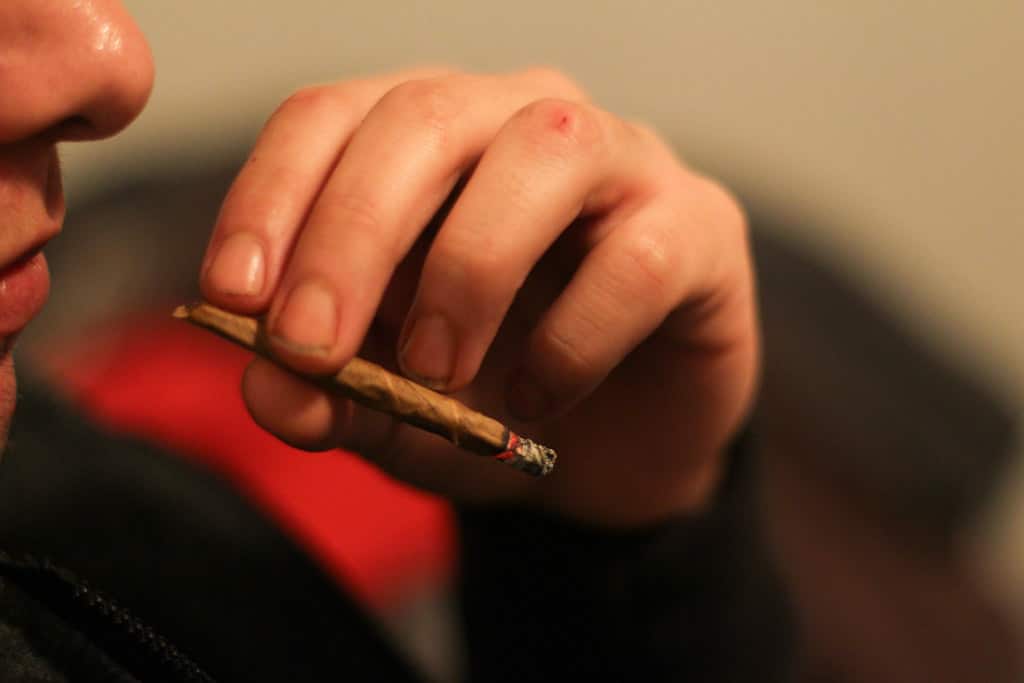Opening up jars of Moon Valley Cannabis is almost sickening. The aroma coming off of these buds is so strong it’s hard to take them in all at once. I’m gagging on pure terpenes after trying to sniff a few cultivars in the Moon Valley line-up: Modified Grape, Unicorn Runtz, Watermelon Zonkers, and their first in-house breeding creation, Neon Panther; they all smell incredibly intense. The experience is like walking into a smoothie bar, buying citrus at the farmers’ market, or spending a few hours inside a dimly lit tiki lounge. Cannabis growers have long searched for the best cultivation methods to grow the most aromatic, flavorful, and potent flowers. Now, science is showing that microscopic organisms—namely beneficial bacteria and fungi found in soil—are key players in producing cannabis with extraordinary fragrances, tastes, and effects.
Since its leap into the adult-use cannabis market in 2021, Moon Valley has made a name for itself amongst the most discerning weed smokers and racked up an impressive number of awards for its indoor soil-grown cannabis. With sustainability in mind, Moon Valley does things like using reclaimed water to make its ice water hash and rosins, but the main thing that the cannabis company uses to market itself is “living soil,” or soil that contains a dynamic living ecosystem. And the growing methodology at Moon Valley appears to be working; their flowers take the trend in sweet fruit-forward cannabis into a place so far away from the others in the pack that it’s beyond the gravitational pull of Earth. This begs the question, will we bring weed with us to space? I’d stash this pot in my cosmic go-bag.
Natural Farming
Dipping my nose through Moon Valley’s selections, the scents alone provide a feel-good charge similar to walking outside and taking in the smells of herbs and plants in the air after a cold winter rain—there are wetted leaves of orange and grapefruit trees and blue rosemary blossoms sprinkled in crystalline raindrops. By now, savvy cannabis consumers know that terpenes—the chemical elements of cannabis that produce many of its flavors and aromas—join together with cannabinoids such as THC and CBD to produce weed’s effects. A 2021 study published in the Journal of Cannabis Research shows that the biology present in living soil increases the number and diversity of cannabinoids and terpenes. This happens, the study explains, due to an interplay between microbes within the soil that open biochemical pathways, stimulating their production.
Tobacco with broad leaves and a small pink flower, lamb’s ear-shaped comfrey leaves, blooming purple-flowered basil, and tropical white turmeric, all sorts of plants are growing in 18-inch beds filled with nutrient-rich soil that’s feeding the cannabis growing under LED lights at Moon Valley.
Farmers do not till living soil but build upon it year after year, an action aimed at improving its health in several ways. Compost, filled with fungal life that helps it decompose, is used to help the soil retain water and nutrients. Beneficial insects like earthworms help with things like aerating the soil and provide an additional source of fertilization through their waste. This “no-till” farming style also involves other sustainable agricultural practices such as using cover crops, or plants that are not grown to be harvested, but to enrich the soil and promote biodiversity.
My tour of Moon Valley’s Santa Rosa, California grow was already pretty unique for an indoor cultivation facility, before I reach the fermentation area. There, Production Manager Josh Wegleitner is cutting up two large piles of winter squash, readying it to ferment into a vinegar. Later, he’ll combine that with a natural calcium-rich offering like eggshells and blend it with a compost tea to charge the cannabis plants with nutrients. Fermented plant juice contains microorganisms such as lactic acid bacteria and yeast. The pumpkin he’s chopping smells as sweet as a honeydew melon, and the comfrey he’s fermenting with sugar smells like fresh cucumbers.
Creating fermented plant juice is one of the techniques in Korean natural farming, a cultivation practice that includes extracting nutrients and minerals for plant health from different types of fruits and vegetables. Wegleitner says he feels like a chef creating food for the cannabis plants as he and founder Eli Buffalo open up various tubs of fermented plant juices for me to smell. The plant juices they’re crafting at Moon Valley Cannabis—made from things like ginger, garlic, and orange blossoms—smell almost as delectable as their award-winning cannabis flowers.
“We chop up all sorts of stuff,” Wegleitner says when I meet him mid-cutting pumpkins and collecting their seeds. He’s standing under an outside patio near a container of spent beer mash from a local brewery and a blend of sprouted beans. “This is a seed blend we’re doing sprouted-seed tea with. Those different plants that are growing in there, the fava beans and bell beans, we’ll sprout those, and then we’ll blend them.”
Moon Valley feeds its plants by feeding its soil.
“I don’t know what the plants want and when they want to eat it, so we’re just trying to provide them with a buffet, and whenever they want it, they can take as much as they want,” Buffalo says. “We’re trying to make sure that what we think the plant wants is within the soil.”
Back in the grow room, Buffalo points out the comfrey growing near his award-winning cannabis, including a fruity cultivar called Hawaiian Snowcone, a collaboration from breeder Tiki Madman and Big Al’s Exotics that’s a cross of Detroit Runtz and Hawaiian Plushers. This strain smells and tastes syrupy and sweet, like a bright red tropical fruit punch.
“We turn those into, basically, in-house made nutrients,” Buffalo explains. “The comfrey plant has a lot of well-balanced nutrition. It’s got a lot of nitrogen, phosphorus, and potassium. We’re extracting those minerals and nutrients doing that Korean natural farming prep and basically just mixing it with sugar. And it creates an osmotic process that pulls those minerals and nutrients out of the plant matter, and then we can water that back in with our compost teas and put it back in the soil.”
Buffalo says cannabis grown in living soil provides a smoother, more potent, and “cleaner” smoke.
“I honestly think that outdoor living soil is the pinnacle of cultivation,” he says. “But, for me, we can cultivate year-round, we can have multiple harvests consistently and be consistently putting out stuff that’s pretty similar.”
Photo by Chris Romaine, @kandidkush
A Rising Moon
Located in Santa Rosa, California, near the Sonoma Valley, Buffalo named his cannabis company after the city of Sonoma, where he grew up. The name also came via his father who played with the Steve Miller Band for 37 years and started a music label called Moon Valley Music.
Buffalo started cultivating as a non-profit under Proposition 215 in 2015 on a 12-acre ranch a bit further north in Lake County, where he and Wegleitner—a friendship that goes back to kindergarten—grew greenhouse and outdoor flowers and began making ice water hash. When it came to looking towards getting licensed in the adult-use cannabis market that state voters approved in November 2016, Buffalo switched gears, obtaining his current facility and growing all indoor cannabis with a 3,000-square-foot canopy while building a micro-business that’s completely in-house in terms of processing, manufacturing, and distribution.
The venture officially began in September 2021, and since then, Moon Valley has racked up an impressive grouping of awards for its flowers and hash. In 2022, Moon Valley Cannabis took home first place in the Environmentally-Friendly Indoor category at The Emerald Cup—a competition that began to advance the concept of sustainable outdoor farming and has since evolved to include indoor entries—and eighth place for its Strawberry Banana rosin. In 2023, Moon Valley won third place in the Ice Water Hash category at The Emerald Cup for Super Boof. At the 2023 Northern California Rosin Championship—a competition where entrants all wash the same material—it won multiple awards. Moon Valley placed at the 2023 California Ego Clash and King of Z Hill competitions. They also won a silver medal at the 2023 California State Fair for Candy Rain and took home the top prize at Jimi Devine’s 2023 Transbay Challenge Final with Hawaiian Snowcone.
“It really buried all the challengers,” Leafly’s cultivation expert and Transbay Challenge judge David Downs says of Moon Valley’s Hawaiian Snowcone, a cultivar he describes as tasting as creamy and very sweet like a snowcone with blue and red syrup and a condensed milk capper. “Moon Valley Cannabis grew it in soil indoors in small batches, and it was perfectly cured, as opposed to newer, more hype strains that just weren’t ready for competition.”
Moon Valley also recently released the first cultivar they made in-house, Neon Panther. Neon Panther smells like pink grapefruit with an energizing burst of orange and pineapple flowers. It’s a project they’ve been working on for a few years and involves generational crosses of Blueberry Muffin, Sticky Papaya, Pink Runtz, and Super Boof.
“The smoke is a sharp citrus delight,” says Rachelle Gordon, editor of the cannabis-focused website Greenstate.com.
Courtesy Moon Valley Cannabis
Sustainable Sonoma
Known for its world-class wines and temperate climate, Sonoma County has a history in sustainable farming, beginning with native Pomo, Coast Miwok, and Wintun peoples who named the area Sonoma, or the Valley of the Moon. Internationally famous author Jack London took the name for his book The Valley of the Moon and became an early adopter of sustainable farming on his 1,000-acre Beauty Ranch located on Sonoma Mountain in Glen Ellen. London had learned farming techniques as a war correspondent in Korea and spent the last years of his life on his venture at the ranch.
“I am not using commercial fertilizer,” London wrote, as documented in the book Jack London Ranch Album. “I believe the soil is our one indestructible asset…”
Today, Sonoma continues to boast a number of eco-friendly farms and is a leader in the biodynamic winemaking movement. Before cultivating cannabis, Buffalo worked as a mechanic building custom motorcycles and then got a job managing a repair shop for a biodynamic grape grower, which is how he started his journey learning about soil biology. Before Moon Valley, Wegleitner worked in production at a winery where he learned about fermentation.
In sustainable farming methods—such as Korean natural and biodynamic farming—the focus is on healthy soil that contains a diverse web of organisms.
Courtesy Moon Valley Cannabis
“A diverse soil full of beneficial organisms provide a complex and varied diet that cannot be replicated by synthetic or narrow spectrum organic fertilizers,” says Shango Los, host of the Shaping Fire podcast.
While many cannabis growers and cultivation experts, including Los and Buffalo, believe that outdoor cannabis grown in living soil under natural sunshine produces the most extraordinary flowers, the number of indoor growers cultivating in living soil is on the rise.
“We’re bringing the outside indoors,” Buffalo says.
This article was originally published in the April 2024 issue of High Times Magazine.
The post Turn Up the Terpenes With Living Soil appeared first on High Times.



